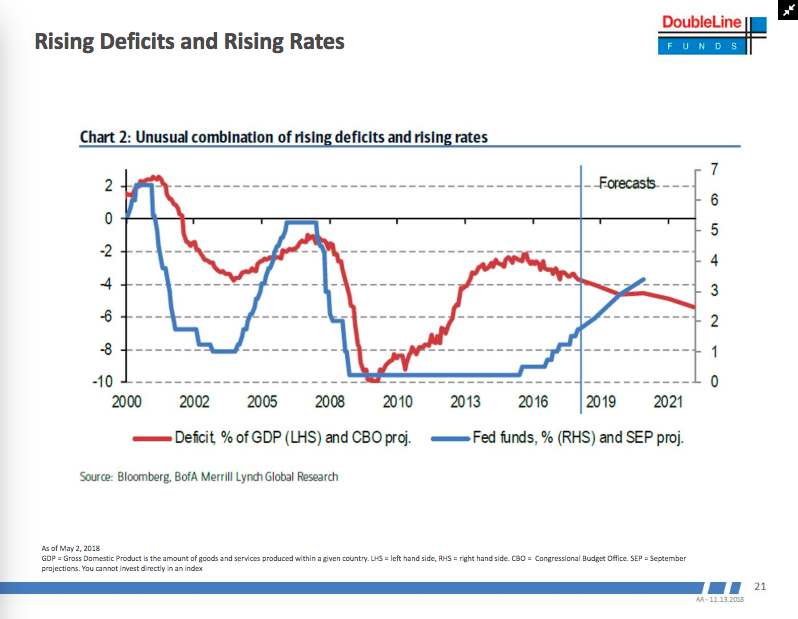Gundlach: The U.S. economy seems to be on a 'suicide mission'
Bond investor Jeffrey Gundlach, the founder of DoubleLine Capital, reiterated his assertion that the U.S. is “on a suicide mission” by increasing its deficit while the Fed is raising interest rates.
Gundlach made the comments during a webcast on Tuesday afternoon shortly after the U.S. Treasury reported that the federal government ran a budget deficit of nearly $100.5 billion during October, an approximately 59% increase from the same month a year ago. October marks the beginning of fiscal 2019. The deficit is expected to move above $1 trillion this year.
Gundlach showed a chart highlighting an “unusual situation” of rising deficits amid rising interest rates.
“It’s very strange that we have a rising deficit so late in an economic expansion and what’s supposedly a good economy, and we saw earlier GDP is nominal at 5.5% year-over-year, and real is 3.0% so for the last year it has been a good economy,” Gundlach said. “It’s very bad that the deficit is rising.”
Like many others, Gundlach attributes the recent pop in economic growth to the growth in the deficit.
“When the deficit goes up, it’s stimulative to the economy. That’s good in the short term, but it’s borrowing from the future,” he said.
On the chart, the blue line represents the Fed funds rate and the red line is the deficit. During the early 2000s, the red line and the blue line moved in the same direction. To put it another way, when the blue line goes down, the means the Fed cut rates, and the deficit expanded. Part of that can explained by a lousy economy that lowers tax receipts and increases government outlays, but there’s also generally some stimulus in there to help the economy pull out of that recession. The red line goes up during good a good economy because the deficit is supposed to shrink. The red line going up changed in the aftermath of the global financial crisis when deficits shrank while rates remained low.

“When the Fed started raising rates, very strangely, the deficit started rising because, of course, of the policies put in place in the aftermath and prior to the election. Now we see we are raising rates again while the deficit as a percentage of GDP is rising.”
Gundlach noted that the red line on the chart shows a 4% deficit as a percentage of GDP, but he explained that’s “really misleading” because the national debt went up $1.3 trillion in fiscal 2018. It’s an even more dire picture for the national debt.
Alarming trends
“So that means with $1.3 trillion increase in national debt it actually means that the debt went up by 6% of GDP. So the forecast out here by the CBO — they use the official statistics of the government — but the statistics do not include the loans for the Social Security system and those loans take the national debt growth to 6% of GDP. If we put quantitative tightening on top of that, we’re talking about something close to $2 trillion of accumulation of the national debt increase and the quantitative tightening at a maximum.”
He said this is a reason why rates have been “stubborn to fall” even though there’s global stock market weakness and more recently some weakness in the U.S. stock market.
He called these “very alarming trends” and a “very dangerous game we’re playing” because there are $7 trillion worth of Treasuries maturing in the next five years and the average coupon on those treasuries is a little over 2%.
“If you look at the screen of the yield curve today, the yield curve, it basically has a three-handle across the board and so those bonds, when they mature, will have to be replaced unless we have a budget surplus, which obviously is not the trend presently with higher cost debt. And so we’ll have yet another perhaps $150 billion or so of interest expense five years from now if interest rates are raised along in sync with the Fed’s stated plan to continue to hike rates pretty much at a quarterly rate.”
The bottom line is the U.S. is already in deep debt, and experiencing a “troubling” deficit-to-GDP during a good economy, and “voluntarily raising” its interest costs.
“This is not a good situation,” Gundlach said, before adding, “It seems like we’re on a suicide mission by increasing our debt and increasing the cost of that debt simultaneously. I’m quite sure this is going to be an issue that’s going to be important within 5 years at the absolute maximum.”
During the Q&A portion of the webcast, Gundlach said he thinks the national debt will be devalued and the problem of the deficit will be solved via entitlement reform “once the nation wants it” and “realizes that we are on a path that’s going to lead to a catastrophe if we don’t address it.”
Julia La Roche is a finance reporter at Yahoo Finance. Follow her on Twitter.
